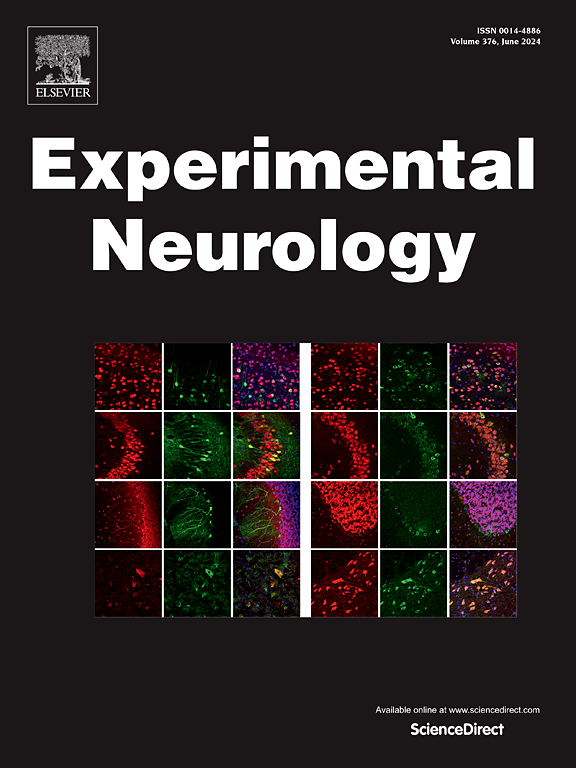Differential evaluation of neuromuscular injuries to understand re-innervation at the neuromuscular junction
IF 4.6
2区 医学
Q1 NEUROSCIENCES
引用次数: 0
Abstract
Peripheral nerve-crush injury is a well-established model of neuromuscular junction (NMJ) denervation and subsequent re-innervation. Functionally, the skeletal muscle follows a similar pattern as neural recovery, with immediate loss of force production that steadily improves in parallel with rates of re-innervation. On the other hand, traumatic injury to the muscle itself, specifically volumetric muscle loss (VML), results in an irrecoverable loss of muscle function. Recent work has indicated significant impairments to the NMJ following this injury that appear chronic in nature, alongside the lack of functional recovery. Thus, the goal of this study was to compare the effects of nerve and muscle injury on NMJ remodeling. Even numbers of adult male and female mice were used with three experimental groups: injury Naïve, nerve crush, and VML injury; and three terminal timepoints: 3-, 48-, and 112-days post-injury. Confirming the assumed recoverability of the two injury models, we found in vivo maximal torque was fully restored following nerve-crush injury but remained at a significant deficit following VML. Compared to injury Naïve and nerve-crush injury, we found VML results in aberrantly high trophic signaling (e.g., neuregulin-1) and numbers of supporting cells, including terminal Schwann cells and sub-synaptic nuclei. In some cases, sex differences were detected, including higher rates of innervation in females than males. Both nerve crush and VML injury display chronic changes to NMJ morphology, such as increased fragmentation and nerve sprouting, highlighting the potential of VML for modeling NMJ regeneration in adulthood, alongside the established nerve-injury models.
神经肌肉损伤的鉴别评估,了解神经肌肉接头处的再神经支配。
周围神经挤压伤是神经肌肉接头(NMJ)去神经支配和随后再神经支配的一个成熟模型。从功能上讲,骨骼肌的恢复模式与神经恢复类似,都是立即丧失力量,并随着神经再支配率的提高而稳步改善。另一方面,肌肉本身的创伤性损伤,特别是肌肉体积损失(VML),会导致肌肉功能不可恢复的丧失。最近的研究表明,这种损伤对 NMJ 造成了严重损害,而且这种损害似乎是慢性的,同时缺乏功能恢复。因此,本研究的目的是比较神经和肌肉损伤对 NMJ 重塑的影响。本研究使用了数量相等的成年雄性和雌性小鼠,分为三个实验组:损伤新生组、神经挤压组和 VML 损伤组;以及三个终点时间点:损伤后 3 天、48 天和 112 天。我们发现,在神经挤压损伤后,体内最大扭矩完全恢复,但在 VML 损伤后,体内最大扭矩仍明显不足,这证实了两种损伤模型的假定恢复能力。与正常损伤和神经挤压损伤相比,我们发现 VML 会导致营养信号(如神经胶质蛋白-1)和支持细胞(包括末端许旺细胞和突触下核)数量异常增多。在某些情况下,还发现了性别差异,包括女性神经支配率高于男性。神经挤压和 VML 损伤都显示出 NMJ 形态的慢性变化,如碎片增加和神经萌发,这凸显了 VML 与已建立的神经损伤模型一样,在模拟成年期 NMJ 再生方面的潜力。
本文章由计算机程序翻译,如有差异,请以英文原文为准。
求助全文
约1分钟内获得全文
求助全文
来源期刊

Experimental Neurology
医学-神经科学
CiteScore
10.10
自引率
3.80%
发文量
258
审稿时长
42 days
期刊介绍:
Experimental Neurology, a Journal of Neuroscience Research, publishes original research in neuroscience with a particular emphasis on novel findings in neural development, regeneration, plasticity and transplantation. The journal has focused on research concerning basic mechanisms underlying neurological disorders.
 求助内容:
求助内容: 应助结果提醒方式:
应助结果提醒方式:


